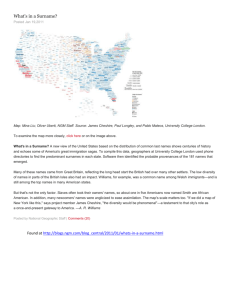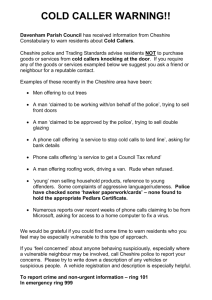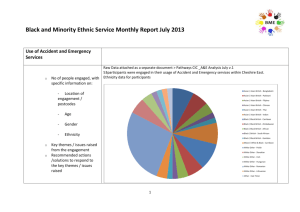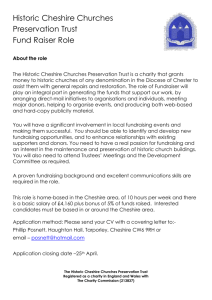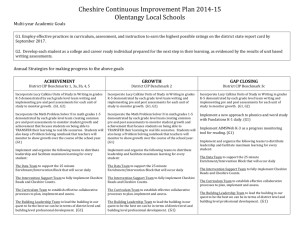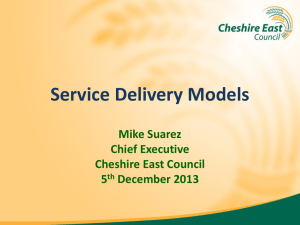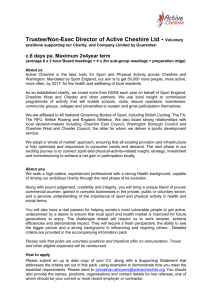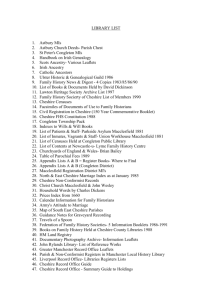Monthly Reporting - February 2014
advertisement
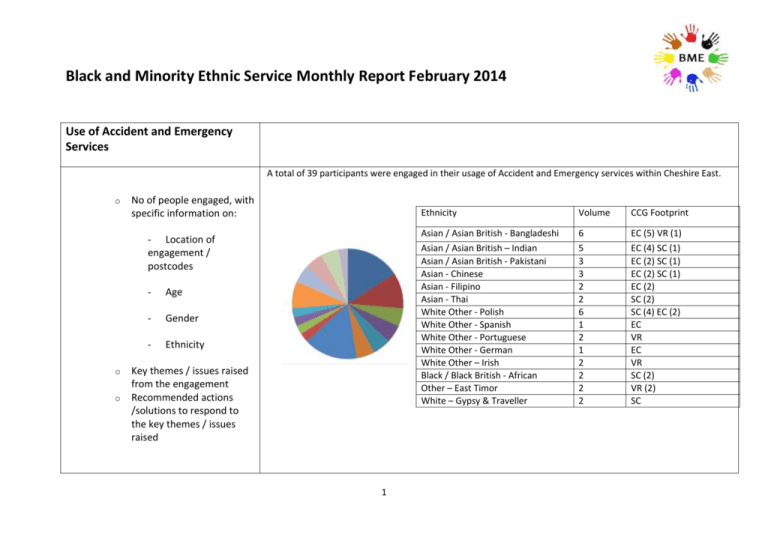
Black and Minority Ethnic Service Monthly Report February 2014 Use of Accident and Emergency Services A total of 39 participants were engaged in their usage of Accident and Emergency services within Cheshire East. o No of people engaged, with specific information on: - Location of engagement / postcodes o o - Age - Gender - Ethnicity Key themes / issues raised from the engagement Recommended actions /solutions to respond to the key themes / issues raised 1 Ethnicity Volume CCG Footprint Asian / Asian British - Bangladeshi Asian / Asian British – Indian Asian / Asian British - Pakistani Asian - Chinese Asian - Filipino Asian - Thai White Other - Polish White Other - Spanish White Other - Portuguese White Other - German White Other – Irish Black / Black British - African Other – East Timor White – Gypsy & Traveller 6 5 3 3 2 2 6 1 2 1 2 2 2 2 EC (5) VR (1) EC (4) SC (1) EC (2) SC (1) EC (2) SC (1) EC (2) SC (2) SC (4) EC (2) EC VR EC VR SC (2) VR (2) SC Services used by those engaged: 17 Macclesfield District General A&E Department 11 Leighton A&E Department 5 Leighton MIU 4 Victoria Royal MIU 2 Congleton MIU Frequency of use within the past 12 months: 31 participants identified that they had used the service only once in the past 12 months: SC (12) EC (15) VR (4) 8 participants had used the services 2-5 times in the past 12 months: SC (4) EC (4) Age of participants: 2 1 participants Under 20: EC (1) 22 participants aged 20-35: SC (9) EC (10) VR (3) 14 participants aged 36-50: SC (6) EC (7) VR (1) 2 participants aged 51-65: SC (1) EC (1) 2 Did not disclose Conditions for admission Leighton A&E Department High Temperature - 2 Injury / Cuts – 4 Feint - 2 Allergy -1 Burns – 1 Cold / Flu – 2 Kidney Infection -1 Hernia - 1 Sickness – 3 Abdominal Pain – 0 Recurring Injury - 2 Stroke – 2 Fracture – 2 Food Poisoning - 1 Child related – 6 *Attendance for Child equated to 43% of total attendance. Predominant conditions for child attendance were high temperature, sickness and cuts (69%) Leighton MIU Sickness – 1 Child Injury - 1 Macclesfield A&E Department Alcohol - 1 Cold / Flu – 2 High temperature - 2 Chicken pox – 1 Sickness and Diarrhoea - 3 Burns – 1 *Child injuries relate to fractures, cuts and burns Congleton MIU Injury - 1 High temperature - 1 Injury - 2 Sickness – 3 Heart - 2 Dizziness - 1 Child Related – 8 Chest Pain - 2 Injury – 4 Injury - 1 Burns - 1 Fracture – 1 Victoria Royal Infirmary MIU Head Injury - 1 Not specified - 1 *data indicates conditions /injuries for attendance at A&E (identifies for some more than one attendance) 3 Reasons for attendance at services: 9 participants attended because their GP surgery was closed 17 Participants attended as they felt their conditions required emergency treatment 8 participants attended as they were not registered with a local GP: SC (3) EC (5) 5 participant attended as there were no available appointments at GP surgery Quality of services 4 15% of participants felt the services they received were poor 44% of participants felt the services they received were average 28% of participants felt the service they received were good 3%of participant felt the service they received were very good 10% of participants felt the service they received was excellent 26% of participants engaged identified that they required support from Interpreters at appointments, 60% in Eastern Cheshire and 40% South Cheshire. Languages where translation support was needed: Polish, Bengali, Urdu, and Punjabi. Only 2 participants suggested that they were offered Interpreter support from services, both Polish patients. Choose Well Campaign o No of people engaged, with 8 Workshops have been facilitated within the community this month, 3 South Cheshire, 3 Eastern Cheshire and 2 within Vale Royal. 2 Have been facilitated at Eaglebridge, 1 Danebridge and 1 at Watersgreen. Of the other 4, 3 specific information on: - Location of engagement / postcodes o o - Age - Gender - Ethnicity Key themes / issues raised from the engagement Identified barriers faced to have been delivered within Children’s Centres at Broken Cross, Hurdsfield and Victoria. The final workshop was delivered at a community event in Alsager. In total, over 50 people have been engaged in the 8 Choose Well workshops. Attendees have spanned across 17 different ethnicities including: Polish, German, Finnish, French, Portuguese, Italian, Russian, Greek, Filipino, Chinese, Bermudan, Sinhalese, Indian, Pakistani, Bengali, East Timorese and Irish. 78% of those engaged identified that they knew nothing about Choose Well. Several commented that they had seen materials at their local GP practice but didn’t really understand or didn’t invest much time in reading through the materials. Some key themes to come out of the workshops were; No appointments available at their GP surgery therefore looked to other services (mainly A&E) Where injuries related to a child, it was identified that A&E would be preferred choice due to accessibility of appointments Not registered to GP, doesn’t access health services, if needed will visit then Language barriers and accessibility of support ie waiting for friends and family to support / availability of interpreters determined when appointments could be attended Gender of HCP Costs of medication 5 o uptake of the Choose Well message Recommended actions /solutions to respond to the key themes / issues raised / barriers faced Past experiences Attitudes of staff; several commented on the ability of hospitals / A&E departments to provide quick, easy consultations rather than waiting several days at GP Aids, such as the computerised check in system available at some surgeries, supported patients where language may be a barrier. Lack of information sharing that leads to duplication can be frustrating for patients Other objectives – Maternity / Smoking / Screening / Elderly People o No of people engaged, with We have this month consulted with CVS Cheshire East, Healthwatch Chehire East, Healthwatch Cheshire West, Cheshire, Warrington and Halton Race Equality Centre, Crewe Womens Aid, PPG’s and Cheshire East Council to specific information on: - Location of engagement / postcodes o - Age - Gender - Ethnicity Key themes / issues raised from the engagement Recommended actions /solutions to share local population data, trends within local areas / wards and to understand different cultural needs/ barriers to services. We have been working with CVS Cheshire East in contributing population data, trends, issues / barriers, engagement opportunities as part of an exercise for the JSNA. When were first approached by CVS, we were asked to consult on data that was originally populated in 2009, therefore somewhat outdated. The population of Cheshire East and Vale Royal has altered significantly over the past 5 years, the makeup of its residents has changed. In sharing data of BME communities living within Cheshire East, it was identified that 92% of Cheshire East population are defined as White British, the remaining 8% made up of over 160 different ethnicities (DORIC 2011, Cheshire East Council). This data, was collected within the Census of 2011, however, since then several more countries have joined the EU, of which continues to expand allowing the rights of EU citizens to move freely within its boarders. There has been nationally, an increase in the number of Visa’s issued for work, study, and family, with an 18% increase in permanent stay visa’s from 2012. Until such time that further data is collected within Cheshire East and Vale Royal, we will continue to make assumptions on what has been collected in 2011. With significant changes to the population over the past decade, services, more so health, need robust strategies and operations to cope with the additional needs of their service users . With a continual growth in its population, 6 respond to the key themes / issues raised Cheshire services need to be suitably resourced to cope with additional needs, such as access to language support services, Cultural Awareness and Equality Training of its service providers to avoid further (non cost effective/ non resourceful) issues arising. If patients continue to be turned away from their GP due to language barriers, difficulties in registering at surgeries, non-effective communication between user and provider, it will undoubtedly put pressure on other services, such as A&E / hospital departments. Ethnicity Data for each CCG footprint (broken down by constituency DORIC 2014) Congleton : 106 Crewe / Nantwich : 133 Macclesfield : 117 Vale Royal: 108 There have been 2 Tulip sessions facilitated during February with 6 attendees at the sessions. We had originally proposed 4 sessions, however there has been a change in the ‘set-up’ of the HV teams and therefore we need to reconnect with the new team. The time out of the sessions has also allowed us to remodel the programme. We are currently looking at other opportunities with the Local Authority, Health Visitors and Children’s Centres to deliver future sessions. We continue to work with the PPG’s at Eaglebridge and Waters Green. Our proposed meeting with Waters Green has been rescheduled until April due the shortage of availability of members and GP’s at the meeting. Delemere surgery at Eaglebridge have asked us to consult on their patient data, identified by ethnicity and look for opportunities. We are hopeful that this will be undertaken in April. The BME Service is delivering a workshop on Thursday 20th March 2014, aimed at local service providers and Commissioners, to identify the change in populations, a more diversified community, understanding how this could impact and to identify solutions for services and their consumers. 7 Asset Mapping o Table of identified community assets with specific information on: - Name - Description - Location - Target audience - Contact details Data is continually being obtained and database updated regularly from engagement with BME communities. We currently have information of over 70 agencies, (local and national) either supported by or facilitated by BME groups / community groups that offer support to local populations within Cheshire East and Vale Royal - Frequency of meetings (if applicable) - Services offered (if applicable Patient Experiences o No of patient stories produced on film with specific information on: - Location - Age Videos continue to be collected with clients / communities on what services are accessed and what were the participant responses. We are currently collecting patient experiences on why they access the services they do, what services are they accessing and their responses to service delivery with a specific focus on Accident and Emergency, knowledge of services, primary, secondary and acute and collaborating with Choose Well. The Case study this month concentrates on a mother who suffers with incontinence and is prone to bladder infections following the birth of her third child several years ago. She is a member of the Gypsy and Traveller 8 o o - Gender - Ethnicity Type of service commenting in (acute hospital, primary care, community provision, mental health etc) Positive or negative experiences community and is embarrassed to talk about her condition openly. When she went to her GP, 8 months after the birth, she was advised on lifestyle changes and exercises that could benefit her. She was handed a set of leaflets however did not understand the information / content within them. When she addressed this with her GP, the GP suggested that she get a friend or family member to help her read through them. Gill was however reluctant to share the information / her condition with family member through fear of embarrassment and has suffered since. Our Health and Wellbeing Advisors have supported her to understand the condition and identified how key lifestyle changes that could benefit. We have been working with her to introduce those lifestyle changes and continue to monitor progression. 9
